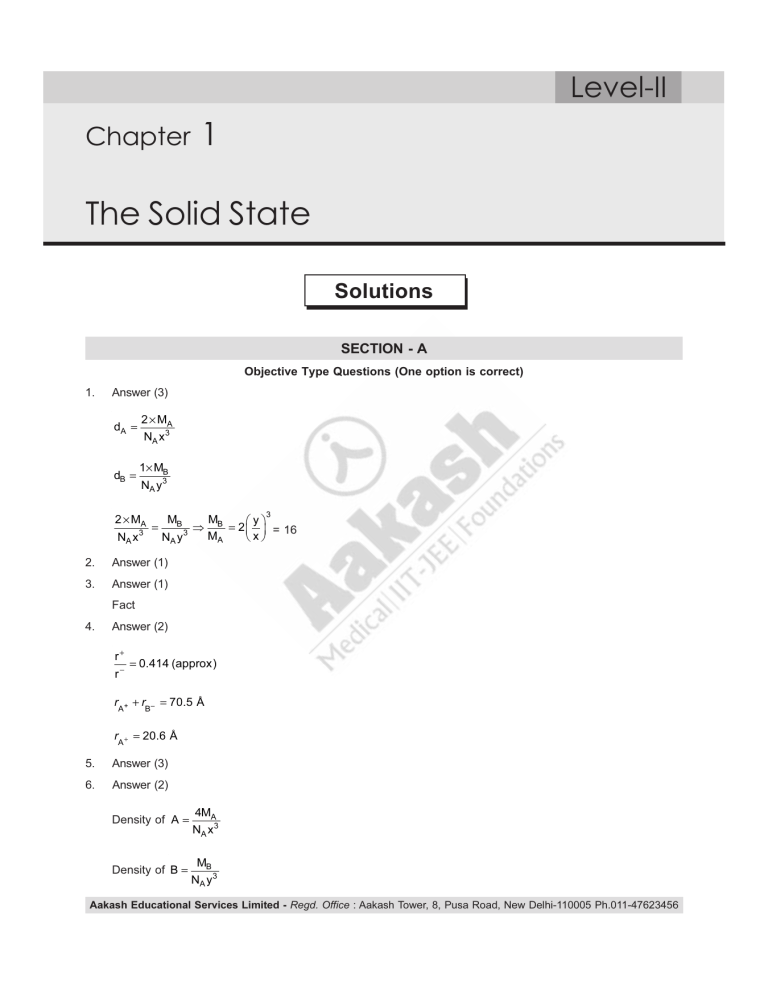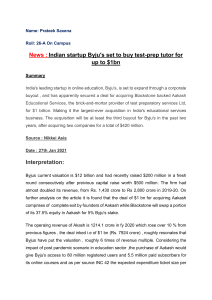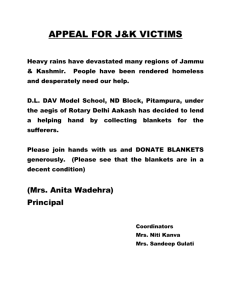
Level-II Chapter 1 The Solid State Solutions SECTION - A Objective Type Questions (One option is correct) 1. Answer (3) dA = dB = 2 × MA NA x 3 1× MB NA y 3 2 × MA NA x 3 = MB NA y 3 2. Answer (1) 3. Answer (1) 3 ⇒ MB ⎛y⎞ = 2 ⎜ ⎟ = 16 MA ⎝x⎠ Fact 4. Answer (2) r+ = 0.414 (approx) r− r r A+ A+ +r B– = 70.5 Å = 20.6 Å 5. Answer (3) 6. Answer (2) Density of A = Density of B = 4MA NA x 3 MB NA y 3 Aakash Educational Services Limited - Regd. Office : Aakash Tower, 8, Pusa Road, New Delhi-110005 Ph.011-47623456 Solutions of Assignment (Level-II) The Solid State 13 4MA MB If dA = dB ⇒ N x 3 = N y 3 A A ⎛M ⇒ 4⎜ A ⎝ MB ⎞ ⎛x⎞ ⎟=⎜ ⎟ ⎠ ⎝y⎠ 3 3 ⎛x⎞ x ⇒ 8=⎜ ⎟ ⇒ =2 y y ⎝ ⎠ 7. Answer (3) d (gcm−1) = Z × M(g) NA × a3 (cm) d ⋅ NA ⋅ a3 =Z M ⇒ 0.2(g / cm3 ) × 6 × 1023 mol−1 × 10 −21cm3 =z 30 g / mol ⇒ 1.2 × 100 =z⇒z=4 30 So unit cell is F.C.C. 8. Answer (3) 9. Answer (2) CN is 8. 10. Answer (3) Mn⎛ 1 ⎞ ⎜ × 4⎟ +1 ⎝8 ⎠ Si⎛ 1 ⎞ ⎜ × 4⎟ ⎝8 ⎠ Fraction of Mn = ⇒ Mn⎛ 1 ⎞ ⎜ + 1⎟ ⎝2 ⎠ Si 1 ⇒ MN3/2 Si1/2 ⇒ Mn1.5 Si0.5 2 1.5 1.5 = = 0.75 1.5 + 0.5 2.0 11. Answer (2) → Coordination number = 6 (octahedral void) 12. Answer (3) 2+ 3+ 3 x 4 1 x 4 Fe ––– Fe ⇒ 3 1 x( +2) + x( +3) = 2 4 4 ⇒ 6x 3x + =2 4 4 ⇒ 9x =2 4 x= 8 9 Aakash Educational Services Limited - Regd. Office : Aakash Tower, 8, Pusa Road, New Delhi-110005 Ph.011-47623456 14 The Solid State Solutions of Assignment (Level-II) 13. Answer (2) x= y= 2 × mass of one metal atom ⎛ 4r ⎞ ⎜ ⎟ ⎝ 3⎠ 3 4 × mass of one metal atom ⎛ 4r ⎞ ⎜ ⎟ ⎝ 2⎠ 3 x 2×3 3 = ≈ 0.92 y 4×2 2 ∴ y > x 14. Answer (3) If atoms along the axis passing through two opposite face centres are removed, crystal will remain neutral. 15. Answer (3) Iron & cobalt are ferromagnetic substances. 16. Answer (3) a Dist. of 1st nearest neighbour (A+) to corner ion B− = 2 a Dist. of 2nd nearest neighbour (B–) = 2 Dist. of 3rd nearest neighbour (A+) = 3 a 2 17. Answer (4) [All the statements are true] 18. Answer (3) Amorphous solids are isotropic in nature. 19. Answer (4) SO2 – Dipole -Dipole interactions 20. Answer (1) C – 3 axis of symmetry is body diagonal. ∴ Number of particles of X removed = 2 Number of particles of Y removed = 1 1 Number of particles of Z removed = 4 Formula of crystal = X6 Y3 Z 15 = X8Y4Z5 4 21. Answer (4) Z × ( 56 + 16 ) Density = N × 5 × 5 × 5 × 10 −24 A ⇒ Z=4 ∴ Mass of a unit cell = 4 × formula mass 22. Answer (2) The colour is due to presence of F-centres in crystal. Aakash Educational Services Limited - Regd. Office : Aakash Tower, 8, Pusa Road, New Delhi-110005 Ph.011-47623456 Solutions of Assignment (Level-II) The Solid State 15 SECTION - B Objective Type Questions (One or more than one option(s) is/are correct) 1. Answer (3, 4) Pseudo solids means behaving like solids but atoms in the solid are having irregular arrangement. Rubber and coke are pseudo solids. 2. Answer (1, 2) Distance between the neighbouring atoms a⎞ ⎛ For primitive ⎜ d = ⎟ ⎝ 2⎠ a ⎞ ⎛ For FCC ⎜ d = ⎟ 2⎠ ⎝ ⎛ For BCC ⎜ d = ⎝ 3. 3 a⎞ ⎟ 2 ⎠ Answer (2, 3, 4) Manner of aggregation of layers in ccp can be represented as ABCA…….. So fourth layer repeats. 4. Answer (1, 4) For hcp packing the no. of effective atoms is 6 and in primitive unit cell. No. of effective atoms = 8 × 5. 1 =1 8 Answer (1, 3, 4) Tetrahedral voids have coordination number 4 and are smaller than octahedral voids. Size of voids depends upon the size of atom and Radius Ratio. T-voids are smaller than octahedral voids. 0.225 to 0.414 for T-voids and 0.414 to 0.732 for O-voids. 6. Answer (1, 3) Voids are surrounded by six atoms at edge centre & body. So, (1) & (3) are correct answers. 7. Answer (1, 3) For Hexagonal packing the coordination number is 12 and contains tetrahedral and octahedral voids. 8. Answer (1, 4) CsCl has BCC structure Cs = 133, Cl = 35.5 Cs+ is present at the centre and 8 Cl– ions are present at the corners. ∴ No. of formula unit (z) = 1 Mass of unit cell = 133 + 35.5 = 168.5 ⇒ Mw = 133 + 35.5 = 168.5 9. Answer (1, 4) In CaF2 : Ca2+ occupies FCC (or ccp) and F ∴ No. of Ca2+ = 8 × F are present in tetrahedral voids 1 1 + 6× = 4 8 2 =1×8=8 Aakash Educational Services Limited - Regd. Office : Aakash Tower, 8, Pusa Road, New Delhi-110005 Ph.011-47623456 16 The Solid State Solutions of Assignment (Level-II) ∴ Formula becomes Ca4F8 ⇒ CaF2 Coordination no. of F =4 Coordination no. of Ca2+ = 8 10. Answer (1, 3, 4) 11. Answer (1, 2, 3) Body diagonal touches : 4 corners ⎫ 4 2 − ⎬ ⇒ Cl removed = + 2 face centres ⎭ 8 2 2 edge centres ⎫ 2 + ⎬ ⇒ Na removed = + 1 & 1body centre ⎭ 4 Thus same number of Na+ and Cl– are removed Rectangular plane touches : 4 face-centres ⇒ Cl– removed = 4 2 4 edge centres ⎫ 4 + ⎬ ⇒ Na removed = + 1 1body centre ⎭ 4 Thus same number of Na+ and Cl– are removed. Tetrad axis touches ; 2 face centres ⇒ 2 − Cl 2 & 1 body centre ⇒ 1 Na+ Thus same number of Na+ and Cl– are removed. Body-diagonal touches 2 corners ⇒ Cl– removed = 2 8 & 1 body centre ⇒ Na+ removed = 1 Thus Na+ removed ≠ Cl– removed. 12. Answer (3) In AB2O4 O2– present as ccp ∴ No. of O2– = 8 × 1 1 + 6× = 4 8 2 ∴ 4O2– are present 8 T-voids and 4 O-voids are present in FCC unit cell B3+ occupy x% of O-voids are occupied, since 2B atoms are present, we can conclude 50% O-voids are occupied ∴ X = 50% Aakash Educational Services Limited - Regd. Office : Aakash Tower, 8, Pusa Road, New Delhi-110005 Ph.011-47623456 Solutions of Assignment (Level-II) The Solid State 17 A 2+ ions occupy tetrahedral voids and y% are occupied. Since only one ion is present it means 1 × (T-voids) are present 8 ∴ y = 12.5% 13. Answer (2, 3) Fluorite is basically CaF2(AB2) Interchanging +ve and –ve ions will give antifluorite structure Coordination no. of A = 8 and B = 4 14. Answer (1, 2) ρ (KBr) = 2.75 g/cm3. a (edge length) = 654 pm We can apply the equation ρ= Z × Mw 3 a × NA ∴ Z = (2.75) ∴ Z= 2.75 × (6.54 × 10−8 )3 × (6.023 × 1023 ) 119 (6.54)3 × 6.023 × 10−1 =4 119 ∴ It is FCC lattice (unit cell) and no. of formula unit = 4 15. Answer (2, 4) Fe3O4 has inverse spinel structure O2– ions forms FCC unit cell Fe3+ occupies 1 (TV) = one Fe3+ 8 Fe2+ occupies 1 (OV) = one Fe2+ 4 Fe3+ occupies 1 (OV) = one Fe3+ 4 Formula ratio of Fe2+, Fe3+, O2– = 1 : 2 : 4 16. Answer (1, 2) In CsCl co-ordination number is 8, this can be converted into NaCl structure (CN = 6) by release in packing that can be achieved either by increase of temperature or by decrease in pressure. 17. Answer (2, 3, 4) In spinel structures anions form ccp in which divalent cation occupy tetrahedral void and trivalent cations occupy octahedral voids. 18. Answer (1, 4) ‘Schottky’ and ‘Frenkel’ defect doesn’t disturb the stoichiometry of the solid. 19. Answer (2, 3) On raising temperature coordination no. changes from 8 : 8 to 6 : 6 and compounds with metal deficiency behave as a p-type semiconductor. 20. Answer (2, 3) KCl is violet. Because of Metal excess defect F-centers are present and because of charge carried in defected crystals, they are better conductor of electricity. Aakash Educational Services Limited - Regd. Office : Aakash Tower, 8, Pusa Road, New Delhi-110005 Ph.011-47623456 18 The Solid State Solutions of Assignment (Level-II) SECTION - C Linked Comprehension Type Questions Comprehension-I 1. Answer (3) There is no change in composition of NaCl when pressure is applied. Only co-ordination number changes. 2. Answer (1) Since it is a FCC lattice and cations occupy the octahedral voids. 2 (R ∴ +R Li+ ⇒ 2 [R 3. 2R ∴ R 2R ⇒ Li+ + 3.62 = 5.40 = (5.40) – (3.62) = 1.78 Li+ Li+ ) = a [Edge length] + 1.81] = 5.40 Li+ ∴ Cl– = 1.78 = 0.89 Å 2 Answer (4) For solid AB, RB– = 100 pm R R 4. A+ B– ⇒ = 0.732 R A+ = (0.732) (100) = 73.2 pm Answer (1) In volume (a3) number of LiCl molecules = 4 ⇒ (5.40 × 10–8)3 cm3 = 4 1 cm3 = 4 3 (5.40) × 10 –24 ⇒ 2.5 × 1022 molecules 5. Answer (2) In a Rock-salt structure number of second nearest neighbours of Na+ in NaCl crystal is 12. Comprehension-II 1. Answer (2) Mg appears at eight corners. ∴ Mg numbers will be 8 × 1 =1 8 ‘O’ appears at centres of faces ⇒ 6× 1 =3 2 Ti appears at centre of the cube. ∴ Only one Ti is present at the centre. Hence formula becomes MgTiO3. Aakash Educational Services Limited - Regd. Office : Aakash Tower, 8, Pusa Road, New Delhi-110005 Ph.011-47623456 Solutions of Assignment (Level-II) 2. The Solid State 19 Answer (2) Since Titanium is surrounded by six faces, therefore, we can say that there are Six (6) neighbouring atoms. 3. Answer (4) MgTiO3 is a Pervoskite structure. 4. Answer (1) Molar mass of MgTiO3 is 24 + 45.9 + (16 × 3) = 117.9 g/mol. ≈ 118 g/mol Comprehension-III 1. Answer (4) Body diagonal plane touches : 4 corners ⇒ removed A = 4 8 2 2 2 face-centres ⇒ removed B = 4 THVs ⇒ removed C = 4 ⎧2 edge centres ⎫ 2 &⎨ ⎬ ⇒ removed D = + 1 4 ⎩1body − centre ⎭ Therefore, compared will become A 2. 1− 1 2 B3 −1 C8 − 4 D 4− 3 2 = AB4 C8D5 Answer (3) Two fold axis is along diagonally opposite edge centres so A removed = 0 D removed = 1 + 2 4 3-fold axis is along body diagonal so A removed = 2 8 3-fold axis passes through opposite face centres, so B removed = 2 2 Therefore, overall the compound will be A 1− 1 4 B3 −1 C8 D 4− 3 2 = A 3 B2 C8 D 5 4 2 ⇒ A3B8C21D10 3. Answer (1) A removed = 1/8 B removed = 3/2 Aakash Educational Services Limited - Regd. Office : Aakash Tower, 8, Pusa Road, New Delhi-110005 Ph.011-47623456 20 The Solid State Solutions of Assignment (Level-II) C removed = 1 D removed = 7/4 Therefore overall the compound will be A 7/8 B3/2 C7 D9/4 i.e., A 7 B12 C56 D18 4. Answer (2) AB = a 2 , AC = a 3 a , AD = 4 2 ∴ Ratio = 2 2 : 3 : 2 SECTION - D Matrix-Match Type Questions 1. Answer A(q), B(p), C(r), D(s) 2. Answer A(r), B(s), C(q), D(p) (A) AlCl3 forms CCP lattice of Cl– . Octahedral holes are occupied by Al3+. Coordination number of Al3+ is 6. (B) NaCl forms CCP lattice of Cl– in which all Octahedral holes are occupied by Na+. Co-ordination number of Na+ is 6. (C) CaF2 form CCP lattice of Ca2+ in which all tetrahedral holes are occupied by F–. C.N of F– is 4. (D) Li2O forms reverse structure of CaF2. 3. Answer A(q), B(s), C(r), D(p) 4. Answer A(r), B(p), C(s), D(q) SECTION - E Assertion-Reason Type Questions 1. Answer (2) In Schottky defect, equal number of positive and negative ions are missing but it does not explain that this defect is shown by crystal’s with high coordination number. 2. Answer (2) Statement-1 is correct as both Na2O and CaF2 structures are same. Only positive and negative ions are interchanged. ∴ Statement-2 is correct but not the correct explanation. 3. Answer (3) Metals are good conductors because of presence of free electrons and electrical conductivity is due to charge carriers, but in Schottky defect positive and negative ions are missing. 4. Answer (4) The covalent forces are stronger than the molecular forces i.e. Melting Point of covalent solids is higher than that of molecular solid. ∴ Statement-2 is correct as lattice points are occupied by molecules. Aakash Educational Services Limited - Regd. Office : Aakash Tower, 8, Pusa Road, New Delhi-110005 Ph.011-47623456 Solutions of Assignment (Level-II) 5. The Solid State 21 Answer (1) Amorphous solids are isotropic as they show physical properties same in all direction. ∴ Statement (2) is the correct explanation of statement (1). 6. Answer (2) Statement (1) is correct & the distance of the nearest neighbours in NaCl structure is a . 2 ∴ So, both statements are correct. 7. Answer (3) Statement (1) is correct as Cl– occupies corners and face centers and Na+ occupies octahedral voids but radius ratio of NaCl structure is fixed, and not varies from 0.414 to 0.732. 8. Answer (3) CsCl is bcc type unit cell. 9. Answer (1) Statement (2) is correct explanation of Statement (1). 10. Answer (4) p-type are formed by metal deficient defect. SECTION - F Integer Answer Type Questions 1. Answer (9) Fact. 2. Answer (4) O2– ions are in HCP Al3+ ions occupy Hence, n = 3. 2 ×6=4 3 Answer (4) Z= 4. 2 rd octahedral holes. 3 ρ × N0 × Vuc M ⇒Z=4 Answer (6) Total no. of spheres whose centre either lie inside or on the side of the square are 36. So, 5. n =6 Answer (2) 4th C.N. of A will be 24 B on corners of adjacent unit cells on each face. 3rd C.N. of A will be 12. ∴ ratio = 2 Aakash Educational Services Limited - Regd. Office : Aakash Tower, 8, Pusa Road, New Delhi-110005 Ph.011-47623456 22 6. The Solid State Solutions of Assignment (Level-II) Answer (5) Two fold axis is along diagonally opposite edge centres, so C removed = (1) and D removed = 2 4 Three fold axis is along body-diagonal, so A removed = 2 8 4-fold axis passes through opposite face-centres So, B removed = 2 2 Originally the molecule is AB3CD3, after removal it will become A Remaining atoms = 1− 1 4 B3 −1 C1−1 D 3− 1 2 1⎞ 3 5 (3 + 8 + 10) 21 ⎛ = ⎜5 + ⎟ +2+0+ = = 4 4 2 4 4 ⎝ ⎠ ∴ x=5 7. Answer (02) C4-axis contains opposite face centre and body centre. C4-axis pass through opposite face centres and body centre. If 2 face centre atom and one body centre atom is removed then formula becomes Na3Cl3. 8. Answer (64) In H.C.P., 8 T.V are inside the unit cell while 12 are at vertical edges (2 on each vertical edge) T.V. = 8 + 12 × 1 = 12 3 One edge in H.C.P. contributes 9. 1 . 3 Answer (12) r+ 1.62 = = 0.58 r− 2.8 AB has NaCl type structure. 10. Answer (13) X = Corners and Face centre Y = Tetrahedral voids If all particles along one body diagonal are removed, it means two corners and two tetraheral particles are removed. X=3+ 6 15 = 8 4 Y=6 X 15 Y 6 ⇒ X 5 Y 8 4 m + n = 5 + 8 = 13 Aakash Educational Services Limited - Regd. Office : Aakash Tower, 8, Pusa Road, New Delhi-110005 Ph.011-47623456 Solutions of Assignment (Level-II) The Solid State 23 SECTION - G Previous Years Questions 1. Answer (D) Packing efficiency = = 2. Area covered by particle Total area 2 × πr 2 a2 2 × πr 2 = (2 2 r)2 = π 4 Answer (B) Number of X atoms/ions per unit cell = 8 × 1 1 +6× =4 8 2 Number of M atoms/ions per unit cell = 1 + 4 × 1 =2 4 ∴ Empirical formula of the compound is MX2. 3. Answer (A) Cation A+ occupies octahedral void formed by anions X–. The maximum radius ratio for a cation to accommodate a octahedral void without distortion is 0.414. Radius of anion X– is 250 pm. RA+ R X− ∴ 4. = 0.414 R A + = 0.414 × 250 = 103.50 104 pm Answer (B, C) A→Schottky defect are favoured by small difference in sizes of cation and anion. B→In Frenkel defect cations are dislocated therefore. (True) C→Electron trapped in lattice are called F-centre. (True) D→Schottky defect decrease density. 5. Answer (A) The formula will be MgAl2O4 Total tetrahedral voids = 8 Total octahedral voids = 4 as only one Mg atom is present hence, n = 1 8 as there are two Al atoms are present hence, m = ∴ m, n = 2 1 = 4 2 1 1 , 2 8 Aakash Educational Services Limited - Regd. Office : Aakash Tower, 8, Pusa Road, New Delhi-110005 Ph.011-47623456 24 6. The Solid State Solutions of Assignment (Level-II) Answer (B, C, D) In CCP, the coordination number for atom in top-most layer is 9. 7. Answer (A, C) Contribution of M = 1 ×2 =1 2 Contribution of X = 1 × 4 =1 4 Formula = MX Distance between M and X = a2 a2 + = 4 2 3 3 a= a = 0.866 a 4 2 Both cation and anion have same co-ordination number, i.e., 8. Assuming, anions are in contact, the ratio of ionic radii of cation M to anion X is 0.732, the minimum radius ratio for a cubical void. 8. Answer (B) 1 1 3 ×1 = 6 The number of effective atom in a unit cell = 12 × + 2 × + 6 2 ⎛ no. of atoms in ⎞ Face corner ( ) ⎜ hexagonal primitive ⎟ (Centre) 9. ⎜ ⎝ unit cell ⎟ ⎠ Answer (A) Volume of HCP unit cell = Base area × height ⎛ 3 2 ⎞⎟ = ⎜6 × a × 4r ⎜ ⎟ 4 ⎝ ⎠ = 6× 2 ⎞⎟ 3 ⎟⎠ ⎛ 3 (2r )2 × ⎜⎜ 4r 4 ⎝ 2 ⎞⎟ = 24 2 r 3 3 ⎟⎠ 10. Answer (D) 4 3 πr 3 Packing fraction = Base area × Height 6× 4 3 πr 3 = ⎛ ⎞ ⎜ 6 × 3 a 2 ⎟ × 4r ⎜ ⎟ 4 ⎝ ⎠ 6× 2 3 = 0.74 % of empty space = (1 – 0.74) × 100 = 26% 11. Answer A(p, s); B(p, q); C(q); D(q, r) 12. Answer (7) Volume of 1 Ag atom = ∴ 4 3 πr 3 4 3 108 πr = cm3 3 6.023 × 1023 × 10.5 ∴ r = 1.6 × 10–8 cm r = 1.6 × 10–10 m Aakash Educational Services Limited - Regd. Office : Aakash Tower, 8, Pusa Road, New Delhi-110005 Ph.011-47623456 Solutions of Assignment (Level-II) The Solid State 25 ∴ Number of Ag atoms in 10–12 m2 πr2 × n = 10–12 m2 n= 10 –12 3.14 × (1.6 × 10 –10 )2 n= 10 × 107 8 n = 1.25 × 107 ∴ The value of x = 7 13. Answer (8) Truncated octahedron contain 14 faces out of that eight are hexagonal and six are square. 14. Answer (2) a = 4 × 10–8 cm (a = edge length) d = 8 g cm–3 (density) d= ZM M = molecular mass (g/mol) NA a3 Z → number of atom in 1 unit cell M= dNA a3 8 × 6 × 1023 × 64 × 10–24 = = 76.8 g/mol Z 4 Mole of solid in 256 g = 3.33 moles No. of atom = 3.33 × NA = 20 × 1023 = 2 × 1024 15. Answer (3.00) MX has NaCl type structure. From instructions, it is clear that in MX ionic solid. Cation M - undergoes CCP anion X - occupies all octahedral voids (i) No. of anions left = 1 (ii) No. of anions added = 3 No. of cations left = 1 (iii) No. of cations left = 0 (iv) No. of cations added = 1 No. of anions left = 3 Final no. of cations in an unit cell = 1 Final no. of anions in an unit cell = 3 ∴ ratio = 3 = 3.00 1 Aakash Educational Services Limited - Regd. Office : Aakash Tower, 8, Pusa Road, New Delhi-110005 Ph.011-47623456


